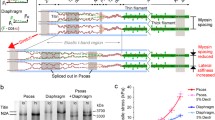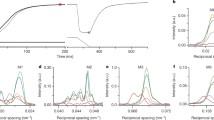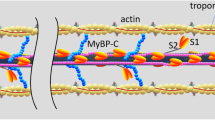Summary
Muscle contraction has long been known to be affected by the osmolarity of the bathing solution. Part of this effect is caused by changes in interfilament spacing in the A-band. We have investigated the variation in spacing of the square lattice of thin filaments within and near the Z-line (the Z-line/I-band or Z-I lattice) in intact frog sartorius muscle over a wide range of osmolarities and compared it with the corresponding changes in the A-band lattice. Both lattices have a lower limit for compression and an upper limit for swelling. The spacing of the Z-I lattice is nearly proportional to that of the A-band, but shows a 2–3% variation at extreme shrinkage or swelling. In normal intact muscle, the osmotically-inactive volume of both lattices is between 20 and 30%. Thesein vivo measurements of lattice spacing differ significantly from those observed in electron micrographs. With moderate variations in osmolarity, lattice spacing and muscle fibre width show similar behaviour, but at extreme osmolarities, the lattice spacing changes less than the fibre width. An equatorial reflection was observed in intact muscle, previously identified in skinned muscle, which does not index on the A-band and which changes with osmolarity in a manner different from that observed for the A-band and Z-I lattices. This reflection may arise from changes in the ordering of the Z-I lattice or may involve components additional to the thick and thin filaments.
Similar content being viewed by others
References
Bergman, R. A. (1983) Ultrastructural configuration of sarcomeres in passive and contracted frog sartorius muscle.Amer. J. Anat. 166, 209–22.
Boyle, P. J. &Conway, E. J. (1941) Potassium accumulation in muscle and associated changes.J. Fhysiol. 100, 1–63.
Elliott, G. F. &Lowy, J. (1968) Organization of actin in a mammalian smooth muscle.Nature 219, 156–7.
Elliott, G. F., Lowy, J. &Worthington, C. R. (1963) An X-ray diffraction and light diffraction study of the filament lattice of striated muscle in the living state and in rigor.J. Mol. Biol. 6, 295–305.
Elliott, G. F., Lowy, J. &Millman, B. M. (1967) Low-angle X-ray diffraction studies of living striated muscle during contraction.J. Mol. Biol. 25, 31–45.
Goldstein, M. A., Michael, L. H., Schroeter, J. P. &Sass, R. L. (1987) Z-band dynamics as a function of sarcomere length and the contractile state of muscle.FASEB J. 1, 133–42.
Gulati, J. &Babu, A. (1982) Tonicity effects on intact single muscle fibres: relation between force and cell volume.Science 215, 1109–12.
Gulati, J. &Babu, A. (1984) Intrinsic shortening speed of temperature-jump-activated intact muscle fibres.Biophys. J. 45, 431–45.
Gulati, J. &Babu, A. (1985) Critical dependence of calciumactivated force on width in highly compressed skinned fibres of the frog.Biophys. J. 48, 781–7.
Higuchi, H. (1987) Lattice swelling with selective digestion of elastic components in single skinned fibres of the frog.Biophys. J. 52, 29–32.
Higuchi, H. &Umazume, Y. (1986) Lattice shrinkage with increasing resting tension in stretched, single-skinned fibres of frog muscle.Biophys. J. 50, 385–9.
Irving, T. C. (1989) Analysis of the equatorial X-ray diffraction pattern of vertebrate striated muscle. PhD Thesis, University of Guelph, Ontario, Canada.
Irving, T. C. &Millman, B. M. (1989) Changes in thick filament structure during compression of the filament lattice in frog sartorius muscle.J. Muscle Res. Cell Motil. 10, 385–96.
Lowy, J. &Vtbert, P. J. (1967) Structure and organization of actin in a molluscan smooth muscle.Nature 215, 1254–5.
Magid, A. &Reedy, M. K. (1980) X-ray diffraction observations of chemically-skinned frog skeletal muscle processed by an improved method.Biophys. J. 30, 27–40.
Mansson, A. (1989) The effects of tonicity on tension and stiffness of tentanized skeletal muscle fibres of the frog.Acta Physiol. Scand. 136, 205–16.
Matsubara, I. &Elliott, G. F. (1972) X-ray diffraction studies on skinned single fibres of frog skeletal muscle.J. Mol. Biol. 72, 657–69.
Matsubara, I., Goldman, Y. E. &Simmons, R. M. (1984) Changes in the lateral filament spacing of skinned muscle fibres when crossbridges attach.J. Mol. Biol. 173, 15–33.
Millman, B. M. &Nickel, B. G. (1980) Electrostatic forces in muscle and cylindrical gel systems.Biophys. J. 32, 49–63.
Millman, B. M. &Bell, R. M. (1983) Lateral forces between actin filaments in muscle.Biophys. J. 41, 253a.
Millman, B. M. &Irving, T. C. (1988) Filament lattice of frog striated muscle. Radial forces, lattice stability and filament compression in the A-band of relaxed and rigor muscle.Biophys. J. 54, 437–47.
Millman, B. M., Racey, T. J. &Matsubara, I. (1981) Effects of hyperosmotic solutions on the filament lattice of intact frog skeletal muscle.Biophys. J. 33, 189–201.
Millman, B. M., Wakabayashi, K. &Racey, T. J. (1983) Lateral forces in the filament lattice of vertebrate striated muscle in the rigor state.Biophys. J. 41, 259–67.
Rome, E. M. (1968) X-ray diffraction studies of the filament lattice of striated muscle in various bathing media.J. Mol. Biol. 37, 331–44.
Rome, E. M. (1972) Relaxation of glycerinated muscle: low-angle X-ray diffraction studies.J. Mol. Biol. 65, 331–45.
Williams, B. A. (1989) Filament lattice spacing in the A-band of frog sartorius muscles in the relaxed and contracting states. MSc Thesis, Univeristy of Guelph, Ontario, Canada.
Yamaguchi, M., Izumimoto, M., Robson, R. M. &Stromer, M. H. (1985) Fine structure of wide and narrow vertebrate muscle Z-lines. A proposed model and computer simulation of Z-line architecture.J. Mol. Biol. 184, 621–44.
Yu, L. C., Lymn, R. W. &Podolsky, R. J. (1977) Characterization of a non-indexible equatorial X-ray reflection from frog sartorius muscle.J. Mol. Biol. 115, 445–64.
Yu, L. C., Arata, I., Steven, A. C., Naylor, G. R. S., Gamble, R. C. &Podolsky, R. J. (1984) Structural studies of muscle during force development in various states.Adv. Exp. Med. Biol. 170, 207–20.
Author information
Authors and Affiliations
Rights and permissions
About this article
Cite this article
Irving, T.C., Millman, B.M. Z-line/I-band and A-band lattices of intact frog sartorius muscle at altered interfilament spacing. J Muscle Res Cell Motil 13, 100–105 (1992). https://doi.org/10.1007/BF01738433
Received:
Revised:
Accepted:
Issue Date:
DOI: https://doi.org/10.1007/BF01738433




